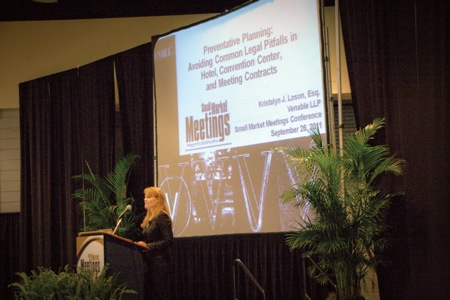
By Dan Limke, courtesy Little Rock CVB
Contracts, green meetings and social media — all pertinent topics in the meetings industry and all covered by speakers at the SMM Conference’s well-attended education sessions. Here is a recap.
Kristalyn J. Loson,
attorney, Venable, L.L.C., Washington
No wonder meeting planners were writing furiously as Kristalyn Loson spoke. The lawyer reviews contracts daily for association and nonprofit clients.
Among the basics to be considered is “everything negotiated should be clearly written in a signed contract,” Loson said. “If you ask for something after a contract is signed, it’s called begging.”
Contract wording should be clear and unambiguous, so that the contract speaks for itself. “Most litigation arises because contracts are unclear,” she said.
Negotiating room rates has become more tricky with the popularity of discount websites. Planners must be specific in stating that their group receives the “guaranteed lowest published rate.”
“Include Internet sales and then make sure you monitor the Internet in case there is a lower rate,” she said.
If a lower rate is offered online, the contract should state that the hotel must match it for all attendees or remove the advertised offer.
Attrition is another area of concern as planners negotiate hotel contracts. Loson recommended to first negotiate a “no attrition/penalties” provision. If that is not possible, she said several measures should be taken to manage penalties. An important point is the obligation of hotels, as a matter of law, to try to resell unused rooms.
In their contract, planners must protect themselves against the “double dip,” in which hotels are paid liquidated damages by the client yet retain the ability to resell the cancelled rooms.
For Loson’s “Five Steps to Prevent the Double Dip,” visit the Small Market Meetings website at www.smallmarketmeetings.com.
Christopher Wood, director of social responsibility and the ASAE
Convene Green Alliance, Washington
Going green can bring more green to the bottom line, a fact that is swaying companies to make their meetings environmentally friendly, according to Wood.
Getting more businesses on the bandwagon will require disproving myths, among them the belief that “environmentally friendly meetings are too expensive,” said Wood.
For the most part, green measures “add to the bottom line,” said Wood, whose own organization, for example, saved $40,000 by sending a preliminary ASAE guide to 5,000 people online instead of printing and mailing it.
Another myth to be dispelled: “If we can’t be 100 percent, why bother.”
“But one green measure will impact the bottom line,” Wood said. As evidence, the Peabody Little Rock, host hotel for the SMM Conference, has saved 200 barrels of oil through its linen reuse program.
To counter the belief that being environmentally friendly requires too much effort, Wood recommended that meeting planners look for partners — cities, hotels, caterers and others —with environmental programs in place.
He urged planners to ask their partners to help them measure the effects of green efforts. For example, a convention center could report how much waste was diverted from the landfill by a conference’s recycling and composting efforts.
“Then the planner can use the result as leverage, to build on successes,” said Wood.
As they take steps, Wood encouraged meeting planners to remember that seemingly small measures do make a difference. For example, one meeting planner who asked for water to be filled only by request at a formal dinner for 2,200 not only saved water, but drew praise from attendees, who felt the service level was more attentive.
“Remember,” said Wood, “nothing in the world is 100 percent green. It is a matter of deciding what shade of green you want to be.”
For Wood’s “Easy Tips for Greening Your Meetings and Events” and the “MeetGreen Sustainability Policy Template,” visit the Small Market Meetings website at www.smallmarketmeetings.com.
Marla Johnson Norris, president and CEO, Aristotle, Little Rock, Ark.
The cost of social media is time, and in many cases, especially in terms of attendance building, investing time in blogging, tweeting and Facebook postings can pay off, according to Norris.
The power of social media is that it allows relationships to be built before a convention or conference begins.
“You can start meeting people before they are even at the meeting,” she said. “People feel more connected and they want to come to your meeting.”
She cited, as an example, a meeting planner in California who blogged about conversations he was having with upcoming speakers and about that would be offered to attendees. As a result, his conference sold out.
Norris said meeting professionals should approach social media with a plan, focusing especially on why they are using social media, allocating their time to it (for example, committing to one tweet a day or one blog post a week) and then strive to be consistent in their social media activity. They must also evaluate their plan and goals and adapt them as needed.
Another societal change that meeting planners must keep in mind is the growing use of mobile phones and tablets. In May, the sales of smart phones and tablets surpassed laptops. “Make sure your website is mobile friendly.”











